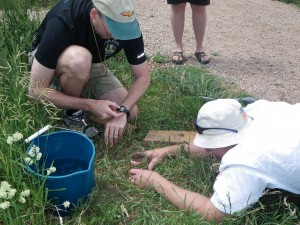Investigating Water Pathways in Schoolyards

Originally appears in the Winter 2012-2013issue
On an overcast day, hundreds of students make their way up the winding driveway of Baltimore City High School. As the students climb the old stone steps and enter the building, large rain drops begin to fall from the sky, splashing onto the manicured lawn, asphalt sidewalks and gently sloping roof of the school building. Puddles form on the playing fields and parking lots and gutters fill with rainwater runoff. Inside the school building, toilets flush, sinks run and store bought water coolers provide students and staff with drinking water throughout the day. On the top floor of the building, one environmental science teacher is using this rainy day as an opportunity to engage her students in a new kind of investigation: tracing water pathways in the schoolyard. Her students pull on their rain coats, grab their notebooks and school maps and head outside into the rain. For the next five days, these students are engaged in a new curriculum unit developed to enhance student learning of water cycle concepts: The School Water Pathways Activity.
Most textbooks depict the water cycle as a simple diagram consisting of clouds, mountains, streams and the ocean. These depictions rarely reflect the landscapes in which the vast majority of students live. This textbook image of the water cycle can lead students to believe that the pathways through the water cycle are simple, linear, and disconnected from their built community. In reality, however, water pathways are complex, nonlinear, and heavily influenced by human action. The goal for the Pathways Activity is to help students learn to trace water along multiple pathways and to consider the local factors which influence the volume of water that flows along any particular pathway.
This content is restricted to subscribers only.
If you are not yet a subscriber, please consider taking out a subscription here.
If you are an existing subscriber, kindly log in or contact us at info@greenteacher.com for more information.





